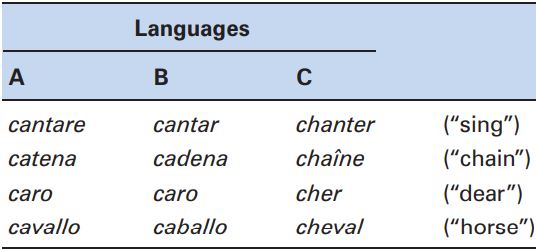


 Grammar
Grammar
 Tenses
Tenses
 Present
Present
 Past
Past
 Future
Future
 Parts Of Speech
Parts Of Speech
 Nouns
Nouns
 Verbs
Verbs
 Adverbs
Adverbs
 Adjectives
Adjectives
 Pronouns
Pronouns
 Pre Position
Pre Position
 Preposition by function
Preposition by function 
 Preposition by construction
Preposition by construction
 Conjunctions
Conjunctions
 Interjections
Interjections
 Grammar Rules
Grammar Rules
 Linguistics
Linguistics
 Semantics
Semantics
 Pragmatics
Pragmatics
 Reading Comprehension
Reading Comprehension|
Read More
Date: 5-3-2022
Date: 2024-09-06
Date: 4-3-2022
|
Sound reconstruction
If we were faced with some examples from three languages, as shown below, we could make a start on comparative reconstruction by deciding what was the most likely form of the initial sound in the original source of all three.

Since the written forms can often be misleading, we check that the initial sounds of the words in languages A and B are all [k] sounds, while in language C the initial sounds are all [ʃ] sounds.
On the evidence presented, the majority principle would suggest that the initial sound [k] in languages A and B is older than the [ʃ] sound in language C. Moreover, the [k] sound is a stop consonant and the [ʃ] sound is a fricative. According to one part of the “most natural development principle,” change tends to occur in the direction of stops Language history and change 227 becoming fricatives, so the [k] sound is more likely to have been the original. Through this type of procedure we have started on the comparative reconstruction of the common origins of some words in Italian (A), Spanish (B) and French (C). In this case, we have a way of checking our reconstruction because the common origin for these three languages is known to be Latin. When we check the Latin cognates of the words listed, we find cantare, catena, carus and caballus, confirming that [k] was the initial sound.
|
|
|
|
التوتر والسرطان.. علماء يحذرون من "صلة خطيرة"
|
|
|
|
|
|
|
مرآة السيارة: مدى دقة عكسها للصورة الصحيحة
|
|
|
|
|
|
|
نحو شراكة وطنية متكاملة.. الأمين العام للعتبة الحسينية يبحث مع وكيل وزارة الخارجية آفاق التعاون المؤسسي
|
|
|